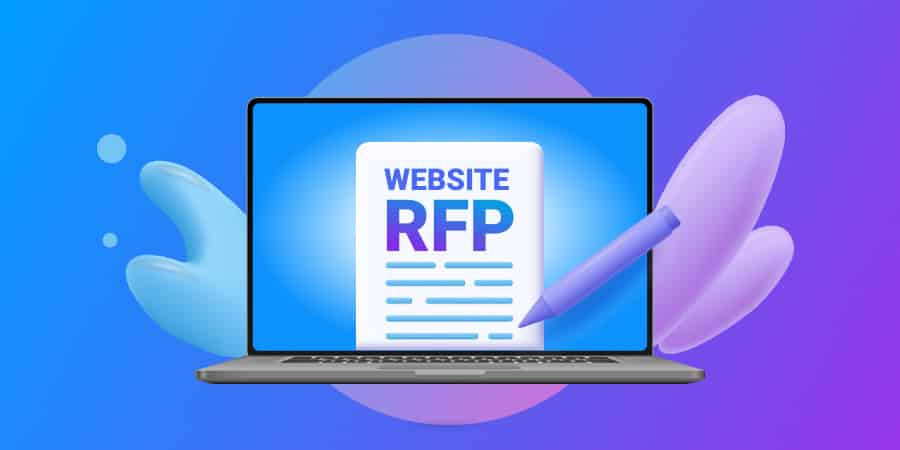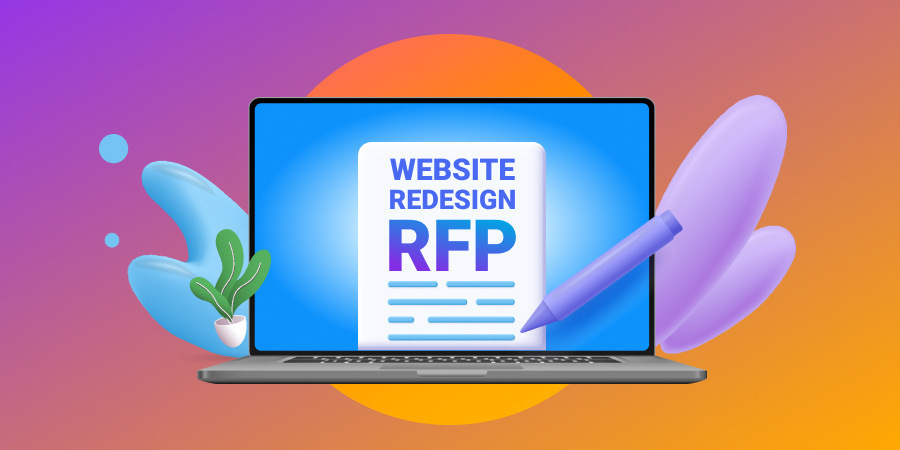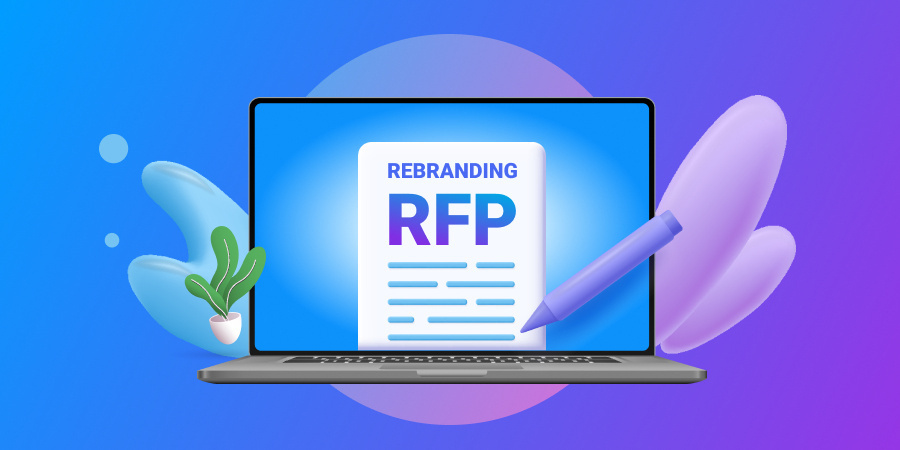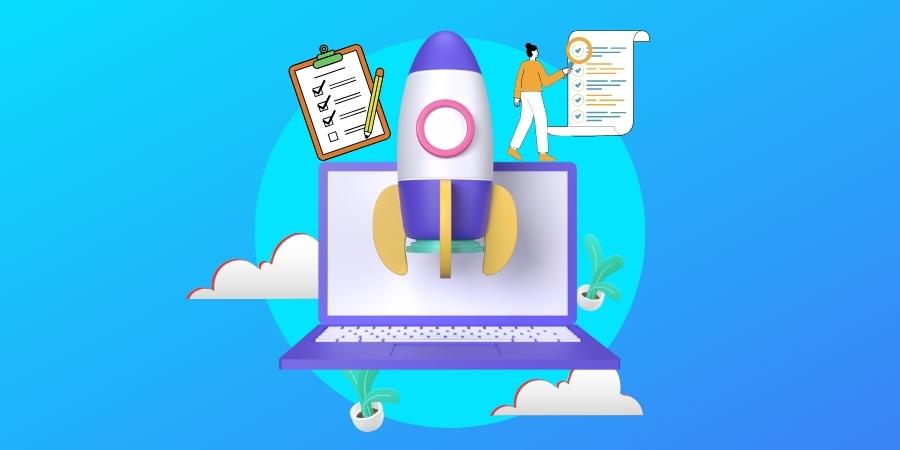Whether you’re looking to launch a new website or you’re interested in a redesign, one of the best ways to find a qualified agency for your project is through a web design request for proposal (RFP).
Through an effective website RFP, you can reach agencies that are interested in your project, then review submissions to determine which agency is the best fit, based on timeline, budget and other factors.
We’ll cover everything you need to know about a website RFP, including a step-by-step guide on how to create one.
Our experts at Digital Silk have reviewed hundreds of RFPs over the years, and they’re ready to share their tips!
The best part? We also prepared a free template you can edit and use for your next RFP. Scroll down to get your copy!
[ez-toc]
Digital Silk builds custom websites. Request a quote
What Is A Website RFP?
A website request for proposal (RFP) is an invitation for agencies to bid on your website project.
A website RFP typically outlines the project requirements and details agencies should consider when tailoring their proposals.
These include your current website challenges, objectives, budget and technical requirements.
Types Of Website RFPs
There are three different types of website RFPs: Those that cater to website design, those that cater to website redesign and those that cater to website development.
1. Website Design RFP
A website design RFP can refer to either a request for proposal for an end-to-end website project or for a specific website design phase of your website project.
For example, if you already have in-house or third-party website planning and/or development resources, and you only require website design support, we recommend naming your RFP document “Website UX and UI Design RFP” to specify the type of services you require.
2. Website Redesign RFP
A website redesign RFP describes how and to what degree your existing website should change. It should define specific pain points of your current website, which sections you want to keep, and detail the areas you want to improve.
This type of RFP should also include details on the project scope, budget, timeline and other key factors.
3. Website Development RFP
A website development RFP outlines the support you need in the planning and/or development phases of your website project, from technology consulting to execution.
Consult with our experts. Schedule A Consultation
How To Write A Website RFP [Sample]
Creating a comprehensive RFP can be a daunting task, especially if you’re new to the process. To help streamline your project RFP, we have crafted a detailed sample that includes the essential aspects when seeking proposals from digital agencies.
1. Include Your Company Background
Create a company overview mentioning the industry you operate in, the products and services you offer and your brand’s unique value proposition.
2. Create A Project Brief
Give an overview of your project listing your current website platform, the reasons that make you consider a new website and the timeline you are looking for.
3. List Your Project Goals
Share the challenges you are looking to resolve and the goals you would like to achieve. Use bullets and try to be as specific as possible. Your goals may include:
- Creating a scalable website that will develop together with your business
- Brand positioning on the market
- Easy-to-use CMS
4. List Your Project Scope
List the services you would like to outsource, such as UX and UI design, website development and more.
5. List The Features & Functionalities You Need
From functionality to marketing features and more, list everything you need to have on your new website.
6. Provide Budget Details
Share the budget you have allocated for your website project.
7. Include Submission Requirements
List the way you would like to receive submissions from agencies along with any additional documents you require.
8. List Additional Details
Don’t forget to include other important details, such as the submission deadline, winner selection criteria and date to announce the winner.
Whether you’re a small business owner looking to revamp your website or a seasoned professional looking for a website upgrade, our downloadable RFP sample will help you adapt the template to suit your specific project needs.
Download Website RFP Template
Email the download link to:
Benefits Of Issuing A Website RFP For Your Project
A website RFP:
- Provides transparency: An effective RFP also allows agencies to understand exactly what you’re looking for and determine whether they have the expertise and capabilities to deliver.
- Expands your reach: According to a recent survey, there are more than 79,000 web design companies in the United States alone. Through a website RFP, you can reach more agencies, giving you a better chance of finding the perfect match for your website project. In addition to contacting agencies separately, you can distribute your website RFP by posting it on your website and informing potential agencies, and/or posting it on RFP websites.
- Allows for more accurate quotes: The detail in your RFP allows agencies to send transparent and accurate quotes for your project.
How A Website RFP Can Determine The Course Of Your Project
Through a detailed RFP, agencies are able to evaluate the scope of your project.
By effectively implementing the RFP process, you will reveal the key information agencies need in order to estimate the time, resources and budget they need to deliver your website project according to your goals and requirements.
This in turn allows you to collect accurate quotes for your project and review estimated timelines to find the agency that is the best fit for your project.
Website Design RFP Best Practices From Experts
At Digital Silk, we regularly review website RFPs to determine whether our creative digital agency is the right fit for a proposed project.
From including straight-to-the-point info to asking vendors the right questions, we’re sharing insider tips from our experts. After hundreds of reviews, they know what it takes to create an effective RFP!
1. Keep It Simple & Direct
While you may be tempted to launch into a five-page introduction about your brand, it’s a better idea to cut to the chase and make your website RFP simple, clear and direct.
You can bet that we’ve seen all kinds of RFPs, and the worst ones are vague, complex and lacking in value.
Effective RFPs are honest and provide specific information, including exactly how you want your website to look, its purpose and the audience it should target.
Example:
Do: “We hope to better understand the landscape of customers, competitors, potential allies and threats as well as how we fit into the workflows of customers and potential customers.”
Don’t: “We want an amazing website!”
2. Include A Clear Budget For Your Project
While it may feel like you’re disclosing too much, stating a clear budget in your RFP will help make it easier for you to narrow down agencies, especially since the average agency answers around 150 RFPs per year.
Example:
Do: “Our budget for this project is set at $35,000, including design, development and testing costs. Please provide a detailed breakdown of the budget, specifying the allocation of funds for each phase.”
Don’t: “We expect the project to be reasonably priced. Please submit your best offer for our consideration.”
After reviewing your budget, an agency will either:
- Send a proposal within your budget
- Send a proposal that shows what they can provide within your budget and what will come at an additional cost
- Disregard your proposal because it’s not the right fit
Website costs can vary based on many different factors, including custom or template design, functionalities, number of pages and more. A transparent RFP will always lead to the most accurate quotes.
3. Establish Your Specific Goals & Complete Scope
While your budget and timeline are important, your goals and the complete scope of your project make up the heart of your RFP process.
These details highlight the scale of how big or small your website project is and the web design services your project needs.
Before you start writing a wish list for your new website, determine what you want your website to do.
- Should it inform or educate your potential customers?
- Should it sell services or products?
Choose your prioritized goal and add secondary goals as needed.
Example:
Do: “Our goal is to increase product sales by 10% by creating a user-friendly website which allows customers to browse our offerings easily, add items to their shopping carts and securely complete transactions.”
Don’t: “We need a new eCommerce website that has all needed features and functionalities.”
4. Ask The Right Questions
While writing your RFP, questions might pop up along the way about specific platforms, functionalities or tools.
Consider adding a questionnaire to your RFP to further facilitate the agency selection process. Questions should focus on the agency’s expertise, relevant capabilities and past experience.
Limit questions to no more than 10. Make sure you add open-ended questions and ask for recommendations on the part of the agency.
More detailed questions can be answered in an interview, should you decide to connect with the agency.
Examples:
Do: “How many Magento websites have you developed so far?”
“Are your teams based in the United States? If not, how do you reconcile time zone differences?”
“Based on our outline requirements, would you recommend that we stay on Sitecore or switch to another platform? If the latter, please elaborate why and what platform you would recommend.”
Don’t: “Can you handle our project?” “Are you familiar with modern design trends?”
5. Be Honest & Precise About Your Pain Points
Be honest with the challenges your brand is currently facing. Are you struggling with generating traffic? Is your navigation confusing?
Addressing issues in your RFP will help agencies pinpoint the key focus areas so they can recommend strategies for improvement.
You can then evaluate proposals from different agencies based on their recommendations.
Example:
Do: “Our messaging isn’t consistent across channels, and we think that may be affecting our conversion rates.”
Don’t: “Our website isn’t converting but we have no idea why.”
6. Include Essential Information
From your contact information to your launch goal, here are additional details to include in your RFP so agencies can send you an accurate proposal bid.
- Contact Details: Include a clear contact name, position, email address, phone number, etc.
- Website RFP/Proposal Timeline: Date your RFP, include a deadline for proposal responses and a date for agencies to hear back from you.
- Submission Requirements: Include a set of guidelines bidders must follow when sending their proposal, such as a proposed budget and timeline, company profile and case studies
- Project Kickoff: Include the date that you’d like an agency to begin work on your project
- Evaluation criteria: Add the evaluation criteria you’ll use to determine the best agency to partner with
Example:
Do: “Please send your proposal in PDF format to our company email by DD/MM/YYYY]. The project kickoff is scheduled for DD/MM/YYYY] and the selected agency will be notified by DD/MM/YYYY].
Your proposal will be evaluated based on your experience, demonstrated expertise in [Specific Technologies/Industries], timeline alignment with project milestones and cost-effectiveness in delivering the outlined scope of work.”
Don’t: “Please send us your proposal at your earliest convenience.”
Send Us Your Website RFP
A detailed and effective RFP can help ensure you reach interested agencies and ultimately choose to partner with the best fit for your website project.
The six best practices that can help you build an effective website RFP include:
- Keep it simple and direct
- Include a clear budget for your project
- Establish your specific goals and complete scope
- Ask the right website questions
- Be honest and precise about your pain points
- Include essential information
At Digital Silk, we take pride in investing our time and efforts in envisioning a custom website solution just for you.
Our award-winning web design agency experts can turn your dream website project into a reality to help you attract your target customers and ultimately, generate leads and conversions.
Whether you’re looking for a new website from the ground up, or a redesign optimized all the way through, our experts are here to deliver a fully customized, on-brand solution.
"*" indicates required fields








